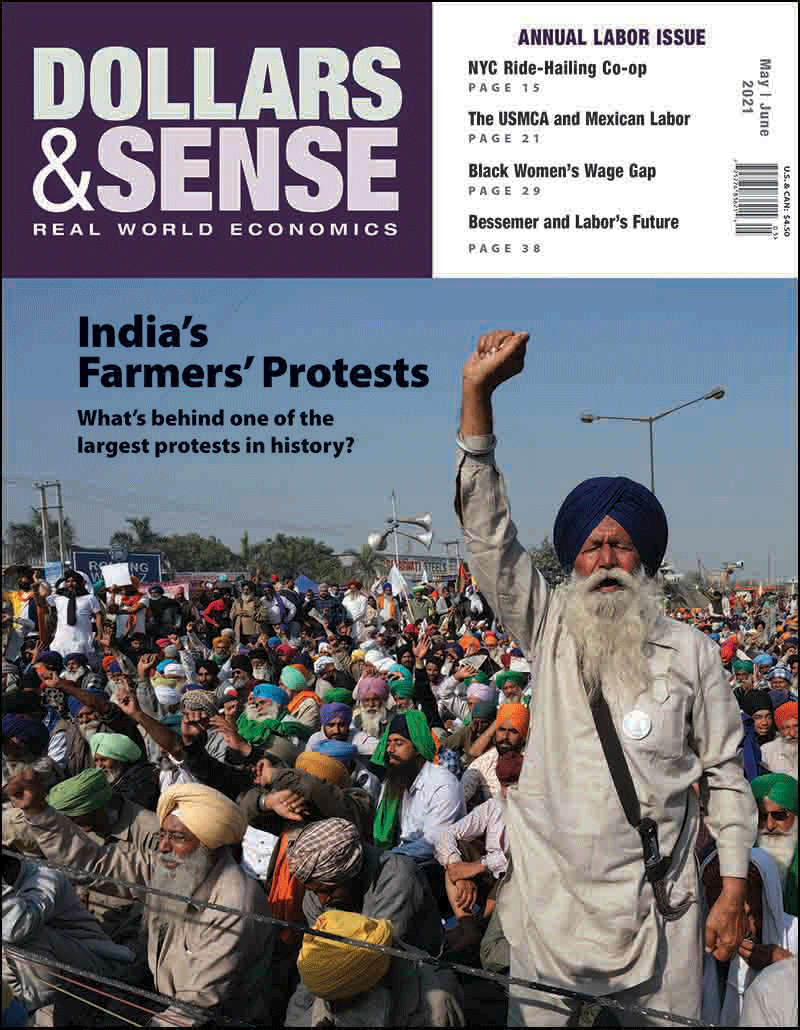Health Insurance for 20 Million is at Risk
If Congress fails to renew the ACA enhanced benefits, millions will be unable to access the health care they need.

Our May/June 2021 Annual Labor Issue is being sent out to e-subscribers today, on International Workers' Day, and the printed magazines are shipping out to print subscribers this week.
Our cover story, by economist Sirisha Naidu, is on India's farmers' protests, which are among the largest protests in history, involving millions of farmers and farmworkers protesting new farm laws passed last fall, with solidarity strikes by millions more industrial workers. The protests are ongoing, even as India endures a huge Covid surge that Arundhati Roy has called a "crime against humanity" in a recent piece in the Guardian.
The situation makes it all the more unforgiveable that the Biden administration has not called for the WTO to issue a Trade-Related Aspects of Intellectual Property Rights (TRIPS) waiver for Covid-19 vaccines.
Read the cover story here, and find the whole table of contents here. (You can subscribe here, if you don't already.) And here is our p. 2 editorial note:
But the final version of ARPA certainly includes much to benefit workers and the labor movement. Thea Lee, head of the Economic Policy Institute, issued a statement that listed some of the big wins: extended pandemic unemployment insurance provisions; $350 billion in aid to state and local governments (see our January/February cover story, “State and Local Government Austerity,” on why federal relief to prevent “subnational” austerity is a labor issue); and “many other important provisions, including stimulus checks, rental and food assistance, money for vaccine distribution, an expansion of Affordable Care Act subsidies, money to reopen schools, and more.” To this list we should add the restoration of multiemployer pension funds for more than a million workers and retirees, in response to a campaign by Teamsters pension activists.
Some on the left, like John Jay College economist J.W. Mason [here], see ARPA as “a decisive break with neoliberalism,” despite its surrender on the minimum wage. Others, like Jacobin executive editor Seth Ackerman [here], point to the fact that key provisions of the Act, like the child tax credit and expanded unemployment insurance, are only temporary and conclude that ARPA is “a collection of temporary expedients to dampen hardship during a crisis” and “not—by itself, anyway—any kind of paradigm shift.” There is time, in other words, for the Democrats to return to austerity.
Two pieces of upcoming legislation may determine whether Biden ends up looking more like F.D.R. than like Obama for workers and for organized labor. One is Biden’s infrastructure bill, which is focused enough on labor to be called “The American Jobs Plan,” and in which infrastructure is conceived broadly enough to include $400 billion for care workers and funding for clean water and high-speed broadband.
The other is the Protecting the Right to Organize (PRO) Act, which, as Arthur MacEwan explains in his column in this issue, “would give workers more power during disputes at work and add penalties for companies that retaliate against workers who organize.” The House has again passed the PRO Act this year, and while its prospects in the Senate are not bright, one of the four remaining Democratic holdouts, Senator Joe Manchin of West Virginia, recently signed on as a co-sponsor.
This is the background for the articles on the U.S. labor scene in this year’s Annual Labor Issue, including MacEwan’s column on the recent Amazon union drive in Bessemer, Ala. and the prospects of reviving the labor movement (he says the prospects are not as bad as some may suppose); John Miller’s column on the (not-so) “new” economics literature on the minimum wage, which the Wall Street Journal editors have yet to catch up on; and labor journalist and activist Luis Feliz Leon on The Drivers Cooperative, a worker co-op in New York City that aims to be an alternative to exploitive ride-hailing companies like Uber and Lyft. And economist and D&S collective member Zoe Sherman interviews economist Michelle Holder about her research on Black women’s wage gap.
Beyond the U.S. labor scene, as there is a massive Covid-19 surge in India, our cover story reminds us that some of the largest protests in history have been happening there. Economist Sirisha Naidu explains how a set of neoliberal farm laws passed last fall have brought millions of farmers and farmworkers together to protest and have drawn sympathy strikes from millions of other workers. And Mateo Crossa and James M. Cypher explain how NAFTA’s successor, the U.S.-Mexico-Canada Agreement (USMCA), is designed to ensure that “Mexico’s oligarchy will continue to have the upper hand over labor, and U.S. and transnational corporations will continue to have happy access to a vast army of low-wage Mexican workers.”
Capping the issue off, D&S collective members (and economists) Jawied Nawabi and Abhilasha Srivastava review two new books on austerity: Why Austerity Persists and Is Austerity Gendered?, so that if Biden and the Democrats do slide back into austerity, D&S readers will understand why they would, and why we need to push them not to.